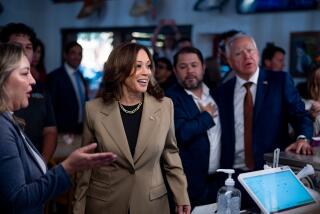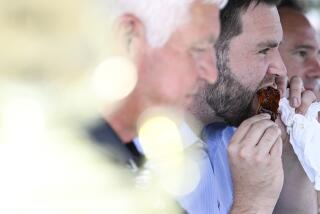Clinton Hopes Administration Diet Helps U.S. Swallow Taxes : Cabinet agencies are ordered to reduce the fat in travel and dining perks. But some protest that they are not really gorging themselves at the public trough.
- Share via
WASHINGTON — As President Clinton enters the Capitol tonight to preach the need for tax increases to help cure the nation’s economic ills, he does so hoping to have shown that his Administration can take its own bitter medicine.
A week before the unveiling of his economic plan, Clinton ordered that officials below the rank of Cabinet secretary drive themselves to work rather than travel in chauffeur-driven government cars, that they use commercial airliners for unofficial trips rather than subsidized government aircraft and that executive dining rooms discontinue below-cost, government-subsidized meals, and perhaps be closed entirely if they “are not essential for the regular conduct of government business.”
A survey of perks conducted last year for Sen. Dennis DeConcini (D-Ariz.) by the Office of Management and Budget showed that about 288 vehicles and 190 drivers are used to transport top-ranking officials around town at an annual cost of $5.7 million. DeConcini’s staff also concluded that taxpayers pay about $4 million annually to operate the 119 executive dining rooms in federal offices. Figures on the cost of government-subsidized air travel have long been unavailable because of complicated record-keeping on the use of government aircraft.
If the dining rooms and the travel were eliminated completely, the dollar savings would still be only a fraction of the $250 billion in spending cuts over the next four years that Clinton is expected to propose tonight.
The cutbacks on limousines and government airplanes are expected to be strictly enforced, but the executive dining rooms will be allowed to remain open as long as they are not a burden on the federal Treasury.
Some agencies closed their separate dining rooms as a symbolic gesture even before Clinton’s announcement last week, but others do not intend to give up the privilege and convenience of having private dining areas in which Cabinet officers and top staffers can conduct business.
“It’s not a perk in the sense that people think--that it’s an elaborate, chandelier kind of a place,” Defense Department spokesman Glenn Flood said of the dining room open to Secretary Les Aspin and about a dozen executive staffers. “It’s a place where national security, classified issues can be discussed without being overheard by people at the other table.”
Many agency officials contend that the public’s perception of the perk does not meet reality. As part of government buildings, the rooms are far from posh, and the food is considered “mediocre” to “good.”
On the recent menu of one large agency dining room was cream of chicken and vegetables in a puffed pastry shell. “That sounds like chicken pot pie to me,” the agency spokesman said.
Although one government official acknowledged that to be invited to eat in the White House mess “used to be considered quite a plum . . . it certainly was not because of the lavishness of the food or the surroundings.” There was really only one reason to go: to be seen.
But that advantage is now in the past. Before long, the White House dining room will be transformed into a cafeteria open to all employees.
Why all the fuss over the granddaddy of the power lunch? A Georgetown University government professor, Steve Wayne, says such perks as dining privileges demonstrate one’s access to powerful decision-makers.
The notion of separate mess facilities for top officials probably is most accepted at the Pentagon, where the rank system is part of military life.
Besides Aspin’s dining room, the Pentagon has four other executive dining facilities for Gen. Colin L. Powell, chairman of the Joint Chiefs of Staff, and for the secretaries of the Air Force, Army and Navy.
Officials said they are not feeling pressure to close the facilities because the meal prices cover the cost of the food.
However, each Pentagon executive dining room averages a staff of 19 whose wages are not charged to the dining room operations because they are military personnel. The salaries for Aspin’s dining room alone total about $460,000 annually.
The departments of Health and Human Services, State, Transportation and Treasury are reviewing their private dining operations to ensure that they are not being subsidized by the federal government.
The Health and Human Services Department has decided to change its buffet-style, hot-plate dining facility into a “carryout” operation featuring sandwiches and salads. The room is not large enough to open for all staffers, spokesman Campbell Gardett said, but officials hope to open it to more people than the 50 it now serves.
The room will not be closed, he said, because officials decided that it enhances office communication. “It serves a purpose as a resource for lunch, to converse, and people do not have to go out of the building. It also serves as a place where people can run into each other.”
At the Treasury Department, officials are quick to downplay the notion that its executive dining room is among the best in town. Sure, it has an excellent view of the South Lawn of the White House, and yes, it is tastefully decorated, with pictures of Treasury securities on the walls.
But the clam chowder and broiled lobster tail lunch for $4.75 that raised public eyebrows last year were a “one-time meal” enjoyed by the previous Administration, spokesman Jack Devore said. Officials are considering raising the meal prices or contracting the food service to reduce the cost to the government, which totaled about $126,000 last year.
Treasury Secretary Lloyd Bentsen, his spokesman said, “took a $50,000 pay cut to accept this job but pays for his own lunch and the lunches of guests like the congressional leadership and the congressional committee chairs.”
Clinton is not the first to suggest recently that executive dining rooms be closed.
DeConcini last month reintroduced a bill he first proposed last year to eliminate several big-dollar perks, including executive dining rooms.
And at the Housing and Urban Development Department, the dining room next to the secretary’s office was closed during the George Bush Administration by then-Secretary Jack Kemp, who took over at a time when the agency was riddled with charges of public corruption and mismanagement.
In the days after Clinton’s inauguration, the Cabinet members for Interior, labor and veterans affairs closed their facilities.
Veterans Affairs Secretary Jesse Brown said after issuing the order that, if the facility was “not good enough for the average employee here, it certainly was too good for me and the other executives.”
Agriculture Secretary Mike Espy did not have an exclusive dining room, but he has removed the “reserved” sign from the table set aside for him in a sit-down dining room open to all employees.
As the trend has grown, the Commerce Department has decided to close its daily kitchen operation for executives. Others are taking similar steps.
At the Education Department, which has no executive dining room, the steward assigned to cook meals for the secretary will now have those duties combined with others.
“There’s not a great deal of money (being saved) and there’s not a great deal of inconvenience,” Georgetown government professor Clyde Wilcox said. But the importance lies in the symbolic message the Administration sends to the public, he said.
“The real test of Clinton’s presidency is going to be his ability to sell the economic package. If you want to sell the message of ‘shared sacrifice,’ you are going to have to show sacrifice,” Wilcox said.
More to Read
Get the L.A. Times Politics newsletter
Deeply reported insights into legislation, politics and policy from Sacramento, Washington and beyond. In your inbox twice per week.
You may occasionally receive promotional content from the Los Angeles Times.










